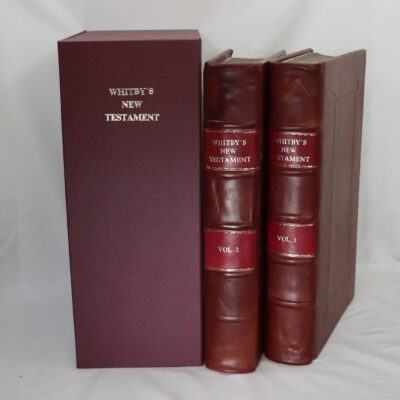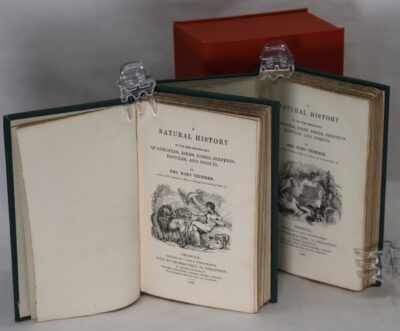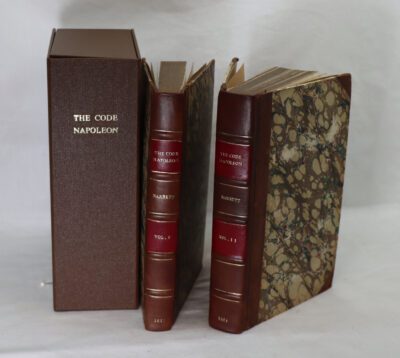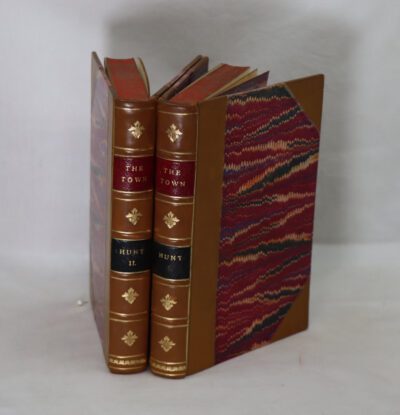Fables de la Fontaine.
By M De Levizac
Printed: 1803
Publisher: Chez Dulauet Co. Soho Square. London
| Dimensions | 11 × 16 × 3 cm |
|---|---|
| Language |
Language: French
Size (cminches): 11 x 16 x 3
Condition: Fine (See explanation of ratings)
FREE shipping
Your items
Item information
Description
Brown mottled calf binding. Gilt cross hatching on the spine. Title gilding worn off.
Warning – Jean de la Fontaine was also an explicit writer of pornography
It is the intent of F.B.A. to provide an in-depth photographic presentation of this book offered so to almost stimulate your feel and touch on the book. If requested, more traditional book descriptions are immediately available.
Jean de la Fontaine (1621 – 1695) was a prolific author who wielded criticism and a sense of morality as a person. During the reign of Louis XIV, writers were not free to directly criticize members of royalty or those of the clergy. With his fables, La Fontaine skilfully circumvents this law by establishing a balance between the classical requirements of literature and those of censorship. By resorting to animals(anthropomorphism), the criticism of the monarchy thus becomes implicit.
Jean de la Fontaine marked history with his Fables. His work occupies a prominent place in the French cultural heritage and certain precepts have entered popular wisdom. But the man was a poor father and husband.
Born in Château-Thierry in the Picardy countryside, on July 8, 1621, Jean de La Fontaine grew up fascinated by reading ancient works. After college, he spent 18 months at the Oratory from 1641. However, not interested in religious studies, he preferred to study law in Paris and graduated as a lawyer in 1649. Parallel to his studies, he frequented a salon of young people passionate about literature, the “knights of the round table” and composed his first verses. In 1653, his wife Marie Héricart, whom he had married in 1647, gave him a son, Charles. Madame de La Fontaine was a cultured woman who, like her husband, frequented a literary salon.
In 1654, La Fontaine published his first comedy: The Eunuch, adapted from the Latin poet Terence. The death of his father in 1658 left him in an uncomfortable financial situation that led him to look for a protector. He then found it in the person of Nicolas Fouquet, superintendent of finance for whom he composed several works including ballads, sonnets and the heroic poem Adonis in 1658. The poet then frequented precious societies and met other great artists including Charles Perrault and Molière. He lives between Paris and Château-Thierry, his hometown, where he is the private master of water and forests.
When Fouquet fell into disgrace in 1661, La Fontaine remained loyal to him and defended him with his poetry in the Elégie aux nymphes de Vaux in 1662 and the Ode to the King the following year. Following these publications, the poet preferred to go into exile for a while in Limoges. During this trip, he wrote to his wife a series of letters that were published in 1663 under the title La Relation d’un Voyage de Paris en Limousin and which brought together descriptions of the landscapes and cities crossed. On his return to Château-Thierry a few months later, La Fontaine courted the Duchess of Bouillon and persuaded her to become his new protector. In 1664, she allowed him to obtain in Paris the post of gentleman serving with his new benefactor, the Duchess of Orleans. He then enjoyed success in the salons and published many works, including the three collections of Tales and News in Verse published in 1665, 1666 and 1671. He also tried his hand at the novel with The Loves of Psyche and Cupid (1669).
The Fables of the Fountain
In 1668, La Fontaine published his first collection of Fables, which was a huge success. It brings together 124 fables dedicated to the Dauphin, son of Louis XIV. The poet staged animals to criticize men and denounce the great problems of his time. In 1678 and 1679 two more collections of Fables appeared, containing 87 additional fables. His Fables, appreciated by young and old alike, remain current thanks to the simplicity of their language and their pictorial form. Indeed, even if nowadays censorship has disappeared, the narrative strategy adopted by La Fontaine – using animals to represent the great moral traits of human beings – remains as clever and funny as ever. The fabulist often drew his inspiration from older fables, written by Aesop, Horace or Pilpay, and he renewed this genre by completely reinventing its form: the short story then becomes an essential element, in the same way as is the didactic morality that concludes it. The Raven and the Fox, The Cicada and the Ant, The Lion and the Rat, The Wolf and the Lamb are among the most well-known fables of La Fontaine.
How many fables did Jean de la Fontaine write?
In total, nearly 248 fables are attributed to Jean de la Fontaine, 243 of which are taken from the three collections he published between 1668 and 1694. To better understand, the three collections were later divided into 12 books (numbered in Roman numerals from I to XII). Because of his mastery of poetic art and his lack of interest in prose, Jean de la Fontaine wrote his fables in the form of verse. Several of them such as The Cicada and the Ant or The Raven and the Fox have been taken from works of antiquity, and in particular from the Greek Aesop, considered by many to be the first fabulist. The last collection of the Fables de la Fontaine was published in 1694, less than a year before the author’s death.
Jean de la Fontaine, father and casual husband
Jean de la Fontaine, aged 26, married Marie Héricart on 10 November 1647. She is only 14 and a half years old. In 1652, the couple had one child, Charles. Very quickly, La Fontaine is tired of his wife and abandons her. In his Historiettes,the writer Tallemant des Réaux writes: “His wife says that he recovers so much that he is sometimes three weeks without believing that he is married. It is a coquettish that has been governed quite badly for some time: it does not torment itself. It is said: but such a cajolle vostre femmes – Ma foy! he replies that he is doing what he can; I don’t care. He will get bored of it as I did. This indiference enraged this woman, she cuttle with sorrow.”
Famous libertine, the temptation of adultery is obviously too great for the man of letters. Jean de la Fontaine prefers to run the skirts of Paris. In a verse by Mona Lisa, he writes :“Recently married: happy, I don’t know.” A claimed faller, he likes to go from woman to woman without attachment, as all biographers point out. “Needless to describe to the good canon his ephemeral liaisons, even when he became a Grison, his passion for the game, his casualness towards his wife and son, Charles, whom he let grow up far from him. He would not even recognize it if he were, by chance, in the same living room.”, writes Le Figaro, which describes the poet’s casual behaviour and the lack of consideration for his wife and son. Abandoned by his father, Charles was entrusted to his most faithful friend, François de Maucroix, who managed his education. Lover of many women, La Fontaine separated from his wife in 1658.
Death of Jean de la Fontaine
After the death of the Duchess of Orléans in 1672, La Fontaine placed himself under the protection of Madame de La Sablière. He then published various works, including a collection of licentious tales that was banned (The New Tales,1674), religious poems (Daphne,1674) and several plays. La Fontaine, a celebrated poet, was then elected to the Académie française in 1683, succeeding Colbert. He defended Latin and Greek literature in 1687, during the “Quarrel of the Ancients and the Moderns”. At the end of his life, La Fontaine was forced by his confessor to renounce his licentious writings. The poet died on April 13, 1695, in the house of the Hervarts, a family of bankers who had taken him under his protection in 1693, at the death of Madame de la Sablière.
Condition notes
Want to know more about this item?

Related products
Share this Page with a friend











